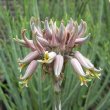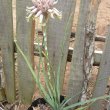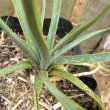| Botanical Name |
|
| Family |
Aloeaceae - The aloe family. |
| Pronunciation |
|
| Common Name(s) |
|
| Plant Group |
- Succulent A plant having fleshy stems or leaves often adapted to dry conditions.
|
| Plant Size |
- Small to Medium
| Tree | 8m to 15m |
| Shrub | 75cm to 1m |
| Perennial/ground cover | 20cm to 40cm |
| Bulb | 30cm to 40cm |
| Succulent | 20cm to 40cm |
|
| Position |
- Light or Dappled Shade Found below trees with sparse, open foliage. Ideal for the protection of herbaceous plants.
- Partial Shade The area is in shade for part of the day and in full sun for part of the day.
- Sun The area is in full sun for all or most of the day, all year round.
|
| General Information |
- Deciduous to Semi-deciduous In warmer areas a deciduous plant may not lose its leaves during winter at all, or may lose its leaves for a very brief period, or may only lose part of its foliage.
- Drought Tolerance: High The plant is well adapted to arid conditions; it can survive long periods of drought and high temperatures without extra water.
- Frost: Tender A plant that will not survive any frost or low winter temperatures.
- Water Wise Plant species originating from low rainfall regions that require less water to survive and thrive than other plant species.
|
| Specific Information |
Aloe myriacantha is a stemless grass aloe with long (300 mm) narrow (10 mm) leaves with numerous, small white teeth along the edges. The leaves are fleshy, bright green, but purple-brown and densely white-spotted near the base. The leaves die back after flowering and new growth is stimulated by veld fires. This is a solitary plant and does not produce suckers.
|
| Ad Break |
|
| Flowers |
| Description |
a single stem with a loose head of drooping, two-lipped flowers
|
| Season |
- Autumn Plants will seldom bloom for the entire season as given in the list, but should flower during a period within these parameters.
|
| Colour |
|
| Growth Rate |
- Moderate Specifying growth rate can be very misleading as there is considerable variation of growth rate depending on type and species of plant, available water, supplementary feeding, mulching and general care, as well as the plants suitability and adaptability to the garden environment.
|
| Plant Uses |
- Attracts bees, butterflies or other insects This plant attracts insects which can be food for birds or other creatures in your garden.
- Container Trees, shrubs and ornamental species that can adapt to growing in a restricted environment.
- Pot Plant A plant that needs a protected environment on a patio or indoors.
- Rock Garden An area constructed of larger rocks, arranged naturally, to emphasise the use of stones as a main element. Generally plants used do not need a lot of care.
- Wild Garden An indigenous garden planted for the benefit of wildlife and birds. Provides food, water, a variety of mini-biomes and no poisonous chemicals are used.
|
| Distribution and Habitat |
widespread in South Africa from the Eastern Cape and KwaZulu-Natal coast and inland to the foothills of the Drakensberg, northwards into Africa as far as Uganda, Kenya and Rwanda, in grassland, Indian Ocean Coastal Belt and Savanna, among rocks in short grassland areas
|
| Planting Suggestions |
This species is not well known in cultivation and is known to be difficult to grow and propagate. Plant in well drained soil. Water occasionally if weather is very dry.
|
| Medicinal Uses |
|
| Ad Break |
|







Discuss this plant
Share knowledge, ask a question or give an experience.